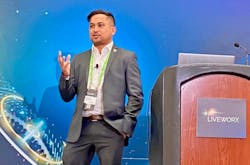How to Move Beyond Smart Factory Pilots
The prevalence of ever-advancing industrial automation technologies and the growing levels of government and private investment initiatives to modernize industry don’t accurately reflect the reality of successful advanced manufacturing technology implementation. The reality is that most industrial companies still struggle not only with how to begin their digital transformation journey but how to scale the successful pilot projects they have completed.
This reality applies to both large and small manufacturing companies. However, since larger companies have more resources to devote to this pursuit, they are often the ones leading the way and helping bring along the smaller manufacturing companies who are often their key suppliers.
One large company doing this is Rolls-Royce—not the automotive division, but the aerospace, defense, electrical and power systems side of the company.
Rashitha Jayasekara, chief of digital manufacturing at Rolls-Royce, gave a presentation at PTC’s Liveworx 2023 event to explain how the company moves beyond the pilot stage in its drive to create smart factory operations at its facilities.
Addressing the variability issue, Jayasekara said, “Our processes aren’t very standard globally, so we look for common winning goals around which to adapt business processes.” In response, Rolls Royce has “created a robust program structure to be agile yet consistent. This includes standardizing where possible and establishing a great support capability with partners and integrators,” he said, adding that the support capability factor is especially important when doing this globally.
As for technology complexity, Jayasekara stressed the importance of understanding your operations technology (OT) landscape. “Map it so you know what to prioritize,” he advised. “You’ll need dedicated data management capabilities to not only understand what’s happening in production but to effectively target scalable and standard OT. This means you’ll need a platform to scale for future standardization efforts and to develop a repeatable test strategy. This is the gatekeeper you need to ensure you’re getting value from the project and directing resources to the right place.”
4 key elements
Jayasekara noted that Rolls-Royce sees four key elements as being critical to the digital transformation: people, business processes, data and technology. With these factors in mind, Jayasekara said the first step is to decide when and where to scale the pilot project. Here, two of the four key factors come into play:
- Technology—what are the commercial risks associated with this technology and has it proven ready for wide scale use in production?
- People—here it’s necessary to differentiate among those who are considered innovators and those who are better described as early- and late-stage adopters. For each of these personality types, you have to consider the level and type of upskilling education needed. Ultimately, you’ll need to answer two questions: Do our engineers really understand the technology and are they happy with it?
Jayasekara repeatedly stressed the importance of focus on people skills. “If you don’t get this right, the technology implementation will not be sustainable and it won’t scale,” he said.
He added that successful smart factory development will require building a diverse team in terms of left-and right-brain thinking. To do this, you can’t just dial into those workers who are adept with technology. You also need those who are effective at communications to get a 360-degree view of the project. These are the people “who can explain the technology to shop floor workers in a language they understand and in ways that will make them feel a part of the team,” said Jayasekara. “A focus on citizen enablement is key to having people on the shop floor work effectively with smart factory systems. They need to be engaged in the development process too.”
Maximize the project’s value
As important as people processes and the right technology are to a smart factory project’s success, you still have to keep your eye on the business factors.
To do this, you need to prioritize the projects around operations that can show distinct value. Two critical components here are the effort required, i.e., how difficult or easy is the project expected to be and developing an accurate picture of its scalability potential.
Jayasekara also advise aligning specific smart factory capabilities you’re targeting with this project to important business outcomes. “This helps leadership see that this project is not just an IT program,” he said.
One aspect of smart factory projects that often isn’t mentioned is that you “have to be bold enough to stop the program when things are not going right,” Jayasekara said. “This involves giving everyone the ability to come together to take stock of the project and focus on what needs to be done to fix it.”
According to Jayasekara, the two biggest outcomes Rolls-Royce has experienced thus far since adopting this approach to smart factory scalability efforts are: improving quality and increasing machine utilization via use of Thingworx.
With this baseline, Jayasekara said Rolls-Royce can now better understand opportunities to improve this process further from both an operations cost and sustainability perspectives.
PTC and Partners Work to Move Users Beyond Pilot Purgatory
Though the service does not yet have a name, representatives from Intel, Dell, Insight (an IT system integrator) and Wachter (an OT system integrator)—along with PTC Kepware—took part in a session at PTC LiveWorx 2023 that outlined a developing set of resources to help manufacturers move beyond the pilot stage of Industry 4.0 initiatives.
Services to be provided by this coalition extend from holding initial discussions with a business to determining their needs by first assessing their IT/OT assets and then creating a blueprint for that company’s digital transformation.
Steve Sponseller, channel director, Americas for Kepware, noted that Intel had the vision to pull this coalition together. Kepware’s role in the coalition is as the interface to standardize data from proprietary systems using its 150 drivers to connect to various plant floor systems and then the send their data wherever it needs to go.
We’re bringing these five companies together as an extension of an established partnership to help solve client issues, said Ben Kotvis, principal architect at Insight. “The outcome Insight brings to this coalition is the ability to implement tailored solutions that address specific needs with as minimal factory disruption as possible.”
“As an OT integrator, our approach is to be platform agnostic so that we can utilize existing equipment and identify needs for upgrades to get where you want to go,” added Ross Turpin, industrial engineering manager at Wachter.
“Intel has been doing IT/OT for 20 years for semiconductor manufacturing,” noted Ricky Watts, industry solutions director at Intel. “We know it takes an ecosystem of partnerships to do Industry 4.0 effectively.”
Dell provides edge gateways for the transmission of Kepware data. “The idea is to start small and scale rapidly,” said Jeff Dymond, global chief technology officer for manufacturing at Dell.
About the Author
David Greenfield, editor in chief
Editor in Chief

Leaders relevant to this article:


